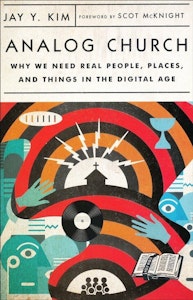 Excerpt from Analog Church
Excerpt from Analog Church
But what if grandma’s church actually had some things right? It’s easy to criticize and quickly dismiss the pipe organ, choir gowns, and oversized pulpits as antiquated relics of the past, but doing so is an exercise in shallowness and snobbery. What if the steady pace with which they gathered, the intentionality with which they worshiped, the depth of their songs, the richness of their liturgy, the warmth of their conversations, the regular ongoing practice of centering together around the bread and the cup of Communion … what if these are all things we still desperately need, maybe even more so now, in the digital age?
Our unchecked pursuit of relevance isn’t only affecting the way we gather to worship. It’s also changing our understanding of what it means to be a community. As more and more churches push headlong into online spaces, people are being asked not only to communicate but also to commune on digital platforms. The Bible, too, is being affected by the digital age, as we turn the grand narrative of Scripture into a series of easily digestible, bite-sized tidbits for personal encouragement and self-help – style motivation. We’re changing the church experience from an extended meal at a dining table into a truncated series of tweets, and we’re losing our aptitude for nuance, generosity, and engagement.
One of the most alarming things about all of this is how blind we’ve become to it. Many church leaders have come to believe that all of this is for the best; we’ve bought and believed the myth that what’s new is always better than what’s old. We are guilty of what C.S. Lewis called “chronological snobbery.”
Admittedly, I myself have perpetuated this ethos over the years. I’ve served on staff at a few different churches throughout Silicon Valley for the last decade and a half, including a medium-sized church, a young church plant, and a multisite megachurch. At each, we felt the strong temptation of the digital age — the temptation to pursue relevance at any cost. We found ourselves spending inordinate amounts of time and energy trying to create spaces that looked, sounded, and felt like whatever we thought was most relatable to popular culture at large. Sometimes we chose wisely and sometimes we took things too far.
Ultimately, though, we discovered that any sort of sustained emphasis on relevance invariably led to satisfied Christian consumers who’d found a product they enjoyed but rarely led to anything deeper. The most transformative experiences people were having in our communities, we slowly realized, had nothing to do with the lights, sound, and spectacle. Transformation was happening in much more tactile ways — through personal relationships and the profound simplicity of studying Scripture, praying, and sharing meals together.
This isn’t a big-church, small-church issue. Churches of all shapes and sizes are falling headlong into the trap of relevance at all costs, digitizing and technologizing anything and everything they can. Only God knows the truest intentions of the men and women leading the charge. But even when said intentions seem well and good on the surface, the responsibility of leading in the local church demands that we excavate down to the depths of our ambitions and thoughtfully consider the methods we’re using to get where we long to go.
Yes, as a church leader I want to serve and reach as many people as I can with the gospel. This is true of most church leaders I know. But often, the desire to “serve and reach as many as we can” in the digital age devolves into methods that essentially equate to, “what’s the fastest, most efficient way for us to get bigger?” This stands in stark contrast to the sort of growth Jesus himself talked about most (I’ll get more into that in the next chapter). As my friend Chris Nye writes, “We cannot abandon the soil for the microwave.… Jesus had remarkable patience and pace, which would frustrate the Silicon Valley.”
This all came to a head for me one Sunday morning as I was walking to the stage to deliver a sermon I’d worked on for weeks. As I was walking up, the service coordinator reminded me, “Jay, don’t forget to look directly into the camera at the back of the room so the campuses feel connected to you.”
Look at the camera so the campuses feel connected to you. The camera is the connection. That was the reminder.
In her sobering book Alone Together, Sherry Turkle says this: “Digital connections … may offer the illusion of companionship without the demands of friendship. Our networked life allows us to hide from each other, even as we are tethered to each other.”2 As I stood on stage, staring into that camera, I felt this tension in real time. I did what was asked. I spoke regularly into that camera, imagining that that small device was the people sitting in rooms all over our city— people I couldn’t see, hear, or feel in any visceral, human way. Something about it felt off. For weeks and months after that experience, even as I did the same thing over and over again, I couldn’t shake the sense that there was a better way forward.
In our increasingly digital world, the church has done what she’s done countless times before — adapted and acquiesced to contemporary culture. Walk into any church in America today, big or small, and you’ll likely be surrounded by digital and technological excellence (or at least the pursuit of it), all for the sake of relevance. This desire to create a church experience that’s familiar and appealing to the digitized masses has led to a dangerous miscalculation — that for a church to grow, thrive, serve, and reach its community, it must be on the front edge of the digital and technological age.
But what if there’s a different path? What if the church of one hundred and the church of ten thousand are both sitting on untapped mountains of potential?
I believe the answer is to go analog. People are hungry for human experiences and the church is perfectly positioned to offer exactly that. In fact, the church is fundamentally designed and intended for this work — to create spaces and opportunities for people from all walks of life to experience true human flourishing, in real time and real space. Unlike anything else in our culture today, the church can invite people to gather in the flesh and to experience the hope that Jesus Christ offers.
Taken from Analog Church by Jay Y. Kim. Copyright © 2020 by Jay Y. Kim. Published by InterVarsity Press, Downers Grove, IL. www.ivpress.com
Text First Published March 2020 · Last Featured on Renovare.org February 2022


